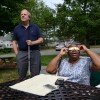I teared up when I saw the trailer for the movie "Harriet," the story of abolitionist, spy, nurse and cook Harriet Tubman. Born into slavery, Tubman escaped her plantation only to return South more than a dozen times to lead her family and other enslaved people to freedom. It’s fair to say that a lot of people only know the barest details about this the woman, whose image millions chose to replace Andrew Jackson as the new face of the $20 bill. The new movie is a fuller telling of her story, which includes her not generally known greatest victory as a Union spy going behind Confederate lines to help free 750 enslaved workers. Harriet Tubman died at age 91 and was buried with full military honors for her Army work. I am thrilled to see the movie chronicle her brilliance and bravery.
So, I’m giving thanks this week for American Black History that is more fully acknowledged — the story of Harriet Tubman and also the four women honored by The Hidden Figures Congressional Medal Act. Earlier this month, President Trump signed the Act to honor the women who were real-life inspirations for the movie "Hidden Figures." They were black women — mathematicians and engineers whose work was instrumental to the success of the space program, for the organization that became NASA and during the time when America was in a space war with the Soviet Union. Back then, they were called human computers. The mainframe computers which became a fixture were still in limited use.
Dorothy Vaughn became the first black supervisor, Mary Jackson the first black engineer and Dr. Christine Darden wrote more than 50 articles on aeronautics design and was the first black women promoted to senior executive service at Langley. Mathematician Katherine Johnson’s skills were especially critical to the success of the program. She completed extensive, complicated calculations on paper, by hand. So reliable was her work that astronaut John Glenn staked his life and career on it. Yes, that John Glenn wanted the calculations from the massive IBM 7090 computers to be double-checked by the computer he knew — the human one. He asked “get the girl to check the numbers.” Katherine Johnson was “the girl” and it took her several days to recheck the calculations, according to Margot Lee Shetterly’s book, "Hidden Figures." Once Glenn was assured that her numbers matched the machine he set off on his flight and became the first American to orbit the Earth. It was 1962, and Katherine Johnson and her colleagues were black women limited by segregation. They could not work in the same building with the engineers who collaborated with the astronauts; these math wizards toiled away in a cramped building with the only restroom they could use.
In 2017, Katherine Johnson was wheeled on stage at the Academy Awards to thunderous applause as the glamorous actresses who portrayed her and her coworkers stood beside her. Pushing her wheelchair was African American NASA flight surgeon Yvonne Cagle — a full historical circle moment if there ever was one. President Obama recognized Johnson with a Presidential Medal of Honor, but the Hidden Figures Congressional Medal Act awards each of the four women individual medals and includes a fifth medal which recognizes “all women who served as computers, mathematicians and engineers” at the pre-NASA facilities between the 1930s and 1970s. 101-year-old Katherine Johnson, and 77-year-old Engineer Christine Darden plan to attend the medal ceremony. Both Mary Jackson and Dorothy Vaughn, who died 14 and 11 years ago, respectively, will receive their medals posthumously. I wish they could all stand in the warm sunshine of the long overdue accolades.
But most of all, I’m thankful that many more people now know and admire their stories and that of Harriet Tubman, and hopeful that from now on they can take their rightful places as icons of history.





